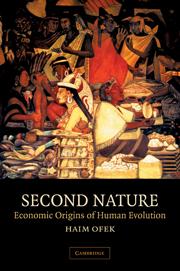Book contents
- Frontmatter
- Contents
- Acknowledgments
- 1 Introduction
- Part 1 Bioeconomics
- Part 2 Paleoeconomics
- 8 Departure from the feed-as-you-go strategy
- 9 The origins of market exchange
- 10 Domestication of fire in relation to market exchange
- 11 The Upper Paleolithic and other creative explosions
- 12 Transition to agriculture: the limiting factor
- 13 Transition to agriculture: the facilitating factor
- References
- Index
11 - The Upper Paleolithic and other creative explosions
Published online by Cambridge University Press: 06 July 2010
- Frontmatter
- Contents
- Acknowledgments
- 1 Introduction
- Part 1 Bioeconomics
- Part 2 Paleoeconomics
- 8 Departure from the feed-as-you-go strategy
- 9 The origins of market exchange
- 10 Domestication of fire in relation to market exchange
- 11 The Upper Paleolithic and other creative explosions
- 12 Transition to agriculture: the limiting factor
- 13 Transition to agriculture: the facilitating factor
- References
- Index
Summary
Modern humans stayed anatomically unchanged at least for the past 80,000 years. On the evolutionary level of organization, anatomically fixed things are expected to stay (nearly) fixed in behavior. Our (anatomically) modern ancestors lived up to this rule for the first half, or slightly more, of their tenure on earth. All hell broke loose in the second. The extraordinary changes in the archeological record starting around 40,000 to 30,000 years ago, and carrying through the height of the last ice age to the onset of the Holocene (some 10,000 years ago), suggest remarkable refinements in behavioral structures unexpected of a morphologically fixed organism. Changes in the record further suggest a remarkable increase in regional and temporal diversity of material structures that up to that point varied little through time and space. The Middle to Upper Paleolithic transition, or the creative explosion as this episode has sometimes been labeled (e.g., Pfeiffer, 1982), is most vividly evident in wall paintings preserved in caves, in portable art, personal ornamentation, and in elaborate burials. More subtle are the sudden refinements in tools, and the rapid expansion into new geographic areas, indeed, into two new continents (Australia and the Americas). Underlying all of this is an authentic economic expansion reminiscent of various mercantile and industrial revolutions in recorded history.
The key question, from an evolutionary viewpoint, is how could such remarkable changes take place in functional behavior without apparent change in morphology. One possible explanation ascribes this turn of events to some neurological change that led to an evolution in behavior without an apparent change in anatomical form (e.g., Klein 1992).
- Type
- Chapter
- Information
- Second NatureEconomic Origins of Human Evolution, pp. 168 - 189Publisher: Cambridge University PressPrint publication year: 2001

